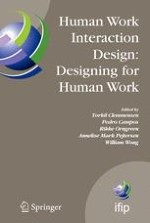This book records the very first Working Conference of the newly established IFIP Working Group on Human-Work Interaction Design, which was hosted by the University of Madeira in 2006. The theme of the conference was on synthesizing work analysis and design sketching, with a particular focus on how to read design sketches within different approaches to analysis and design of human-work interaction. Authors were encouraged to submit papers about design sketches - for interfaces, for organizations of work etc. - that they themselves had worked on. During the conference, they presented the lessons they had learnt from the design and evaluation process, citing reasons for why the designs worked or why they did not work. Researchers, designers and analysts in this way confronted concrete design problems in complex work domains and used this unique opportunity to share their own design problems and solutions with the community. To successfully practice and do research within Human - Work Interaction Design requires a high level of personal skill, which the conference aimed at by confronting designers and work analysts and those whose research is both analysis and design. They were asked to collaborate in small groups about analysis and solutions to a common design problem.
